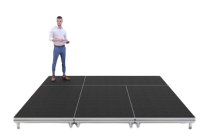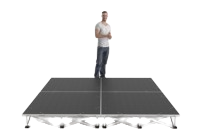Portable Staging for Schools
Finding extra floor space in a busy educational setting seldom proves simple. Sports lessons, assemblies, examinations, community hires – the programme never stops. For that reason, portable staging for schools has become a trusted solution throughout primary, secondary, and further-education venues. Each kit provides a movable performance area that appears when required, disappears when day-to-day activities resume, and never demands heavy engineering or a permanent footprint.
Stage Concepts has collated a concise range that balances classroom budgets with professional build quality. Lightweight yet robust frames, anti-slip tops, and tool-free fixings ensure teaching staff, caretakers, and even student volunteers can handle set-up duties with confidence.
School Portable Staging Planning
Hall dimensions vary wildly, particularly in older buildings. Assemblies might spill into the canteen one month, then squeeze into a sports hall the next. School portable staging counters that problem by operating like building blocks: single decks can remain independent, or connect into sweeping platforms for choir performances and drama showcases. Once lessons resume, sections stack on trolleys and slot into a store cupboard, leaving the hall as uncluttered as it was the day the school opened.
- Modular design handles awkward alcoves or pillars without fuss.
- Single-height or tiered layouts cater to both seated presentations and theatrical productions.
- Add-on guards, rails, and steps enhance safety in multi-level setups.
School Modular Stage Construction Explained
A typical school modular stage utilises a laminated plywood core sealed against moisture ingress. Reinforced steel or composite edging protects against stray instrument cases or hurried foot traffic. All paintwork relies on low-VOC formulations, keeping indoor air quality within educational guidelines. Fast-release clamps connect frames underneath the deck so the surface stays flush, silent, and free from trip hazards.
Load ratings, often expressed in kilograms per square metre, easily exceed the combined weight of performers, props, and instrumentation encountered in the school calendar. Technical sheets accompany every kit, allowing the site manager to log data for insurance records.
Quick Assembly, Minimal Tools
Classrooms run on tight timetables; rehearsal windows can last no more than a lunch break. Time-saving features therefore move from luxury to necessity. Sections tend to connect via spring pins or lever-lock latches – a sharp downward push or a quarter-turn suffices. The absence of loose nuts prevents loss during term-time clear-outs.
- Average two-person assembly time for a six-deck system: under fifteen minutes.
- No electrical tools required; a supplied Allen key often covers periodic tension checks.
- Integrated handles permit safe manual handling procedures compliant with HSE advice.
Safety Measures Specific to Education
While professional touring companies have trained crews, schools rely on mixed-ability teams that can include parents and sixth-form volunteers. Every school event staging package therefore arrives with textured, non-reflective tops to maintain grip under stage lights or bright sports-hall sodium lamps. Rounded corners prevent clothing snags, and underside bracing spreads point loads so chair legs never pierce the deck. Optional guard rails meet the BS EN 12572 guidance for fall protection at modest heights, keeping insurance paperwork straightforward.
Layout Flexibility Across the Academic Year
One of the most frequent compliments received from caretaking teams concerns adaptability. December's nativity needs a raised apron with wing space, but May's public-speaking contest only requires a shallow riser to lift presenters above the audience sightline. A school demountable stage adapts to both within minutes. Additional decks can be hired or borrowed from neighbouring departments thanks to industry-standard sizing, so expansion poses no compatibility issue.
Practical Use Cases
- Concerts and Choir Evenings – angled, two-tier arrangements improve projection and visibility.
- Award Presentations – flat, central layouts speed the flow of pupils collecting certificates.
- Drama and Dance – island stages place the audience on all four sides, enhancing engagement.
- Open Days – miniature platforms elevate faculty speakers above crowded sports-hall floors.
- Community Hire – local theatre groups or charity auctions utilise the hardware, adding revenue to school funds.
Care, Storage, and Inspection of School Event Staging
Maintenance routines remain light. A damp microfibre cloth removes muddy footprints. Periodic visual checks confirm fasteners remain snug. During storage, decks rest on edge-protecting strips to prevent cosmetic dents. Moving parts receive a quick silicone-free lubricant spray at term’s end, concluding a schedule that rarely exceeds fifteen minutes each half-term.
Selecting the Right School Demountable Stage
Several factors influence final selection:
- Hall Footprint – clear ceiling heights, door widths, and fire-exit routes determine maximum stage size.
- Expected Load – orchestral performances with timpani require higher point-load capacity than a poetry recital.
- Frequency of Use – daily assembly demands warrant heavier-duty frames than once-a-term ceremonies.
- Storage Availability – folding leg assemblies aid schools with tight store cupboards; detachable legs suit those with racking space.
An equipment audit led by the premises manager usually clarifies these points in less than an hour. Stage Concepts then provides specification sheets, delivery times, and optional on-site demonstrations so governors may sign off the purchase fully informed.
Why Stage Concepts?
- Extensive experience advising UK academies, maintained schools, and sixth-form colleges.
- Products selected only after field testing in comparable educational environments.
- Clear documentation and responsive after-sales support.
- Warehouse stock held domestically for reduced lead times when term dates loom.
Portable Staging for Schools
Finding extra floor space in a busy educational setting seldom proves simple. Sports lessons, assemblies, examinations, community hires – the programme never stops. For that reason, portable staging for schools has become a trusted solution throughout primary, secondary, and further-education venues. Each kit provides a movable performance area that appears when required, disappears when day-to-day activities resume, and never demands heavy engineering or a permanent footprint.
Stage Concepts has collated a concise range that balances classroom budgets with professional build quality. Lightweight yet robust frames, anti-slip tops, and tool-free fixings ensure teaching staff, caretakers, and even student volunteers can handle set-up duties with confidence.
School Portable Staging Planning
Hall dimensions vary wildly, particularly in older buildings. Assemblies might spill into the canteen one month, then squeeze into a sports hall the next. School portable staging counters that problem by operating like building blocks: single decks can remain independent, or connect into sweeping platforms for choir performances and drama showcases. Once lessons resume, sections stack on trolleys and slot into a store cupboard, leaving the hall as uncluttered as it was the day the school opened.
- Modular design handles awkward alcoves or pillars without fuss.
- Single-height or tiered layouts cater to both seated presentations and theatrical productions.
- Add-on guards, rails, and steps enhance safety in multi-level setups.
School Modular Stage Construction Explained
A typical school modular stage utilises a laminated plywood core sealed against moisture ingress. Reinforced steel or composite edging protects against stray instrument cases or hurried foot traffic. All paintwork relies on low-VOC formulations, keeping indoor air quality within educational guidelines. Fast-release clamps connect frames underneath the deck so the surface stays flush, silent, and free from trip hazards.
Load ratings, often expressed in kilograms per square metre, easily exceed the combined weight of performers, props, and instrumentation encountered in the school calendar. Technical sheets accompany every kit, allowing the site manager to log data for insurance records.
Quick Assembly, Minimal Tools
Classrooms run on tight timetables; rehearsal windows can last no more than a lunch break. Time-saving features therefore move from luxury to necessity. Sections tend to connect via spring pins or lever-lock latches – a sharp downward push or a quarter-turn suffices. The absence of loose nuts prevents loss during term-time clear-outs.
- Average two-person assembly time for a six-deck system: under fifteen minutes.
- No electrical tools required; a supplied Allen key often covers periodic tension checks.
- Integrated handles permit safe manual handling procedures compliant with HSE advice.
Safety Measures Specific to Education
While professional touring companies have trained crews, schools rely on mixed-ability teams that can include parents and sixth-form volunteers. Every school event staging package therefore arrives with textured, non-reflective tops to maintain grip under stage lights or bright sports-hall sodium lamps. Rounded corners prevent clothing snags, and underside bracing spreads point loads so chair legs never pierce the deck. Optional guard rails meet the BS EN 12572 guidance for fall protection at modest heights, keeping insurance paperwork straightforward.
Layout Flexibility Across the Academic Year
One of the most frequent compliments received from caretaking teams concerns adaptability. December's nativity needs a raised apron with wing space, but May's public-speaking contest only requires a shallow riser to lift presenters above the audience sightline. A school demountable stage adapts to both within minutes. Additional decks can be hired or borrowed from neighbouring departments thanks to industry-standard sizing, so expansion poses no compatibility issue.
Practical Use Cases
- Concerts and Choir Evenings – angled, two-tier arrangements improve projection and visibility.
- Award Presentations – flat, central layouts speed the flow of pupils collecting certificates.
- Drama and Dance – island stages place the audience on all four sides, enhancing engagement.
- Open Days – miniature platforms elevate faculty speakers above crowded sports-hall floors.
- Community Hire – local theatre groups or charity auctions utilise the hardware, adding revenue to school funds.
Care, Storage, and Inspection of School Event Staging
Maintenance routines remain light. A damp microfibre cloth removes muddy footprints. Periodic visual checks confirm fasteners remain snug. During storage, decks rest on edge-protecting strips to prevent cosmetic dents. Moving parts receive a quick silicone-free lubricant spray at term’s end, concluding a schedule that rarely exceeds fifteen minutes each half-term.
Selecting the Right School Demountable Stage
Several factors influence final selection:
- Hall Footprint – clear ceiling heights, door widths, and fire-exit routes determine maximum stage size.
- Expected Load – orchestral performances with timpani require higher point-load capacity than a poetry recital.
- Frequency of Use – daily assembly demands warrant heavier-duty frames than once-a-term ceremonies.
- Storage Availability – folding leg assemblies aid schools with tight store cupboards; detachable legs suit those with racking space.
An equipment audit led by the premises manager usually clarifies these points in less than an hour. Stage Concepts then provides specification sheets, delivery times, and optional on-site demonstrations so governors may sign off the purchase fully informed.
Why Stage Concepts?
- Extensive experience advising UK academies, maintained schools, and sixth-form colleges.
- Products selected only after field testing in comparable educational environments.
- Clear documentation and responsive after-sales support.
- Warehouse stock held domestically for reduced lead times when term dates loom.





